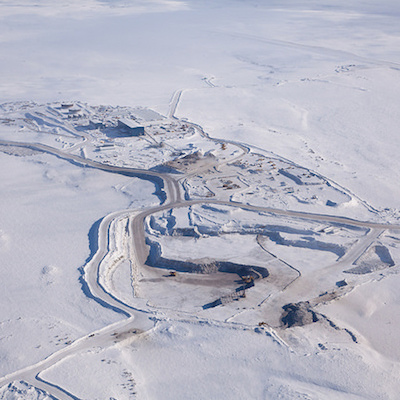Gahcho Kué—The land of diamonds

The Gahcho Kué mine site is located in the Northwest Territories. — Photo courtesy Mountain Province Diamonds Big projects take time. They also take
The Gahcho Kué mine site is located in the Northwest Territories. — Photo courtesy Mountain Province Diamonds
Big projects take time. They also take vision to see the future benefits, patience to deal with the inevitable obstacles and money to make it all happen. The Gahcho Kué diamond mine, a joint effort between Mountain Province Diamonds and De Beers Canada, is certainly big and has taken plenty of all of the above.
The mine, which will be the largest diamond mine in the world, was first envisioned in 1995 when Mountain Province discovered a kimberlite deposit beneath Kennedy Lake in the Northwest Territories they simply named 5034. This initiated a partnership with De Beers in 1997 and so began the long road to completing one of the most ambitious diamond projects the world has ever seen.
Now, over two decades later, the billion-dollar project is over 90 per cent complete and is set to start production in September, a long-awaited day for everyone involved including Mountain Province’s CEO Patrick Evans, who has been a part of the project for 11 years.
“Usually from discovery to completion is 10 years,” said Evans, speaking from Mountain Province’s headquarters in Toronto. “This project has taken a long time.”
According to Evans, the reason for this is twofold, the first being the logistical challenges of the mine’s remote, northern location and its lack of infrastructure.
“We didn’t have an airstrip until three years ago,” said Evans, “which meant we could only fly in during the summer when we could land on water or the winter when we could land on ice. This severely limited the amount of work we could do.”
Evans likened the whole construction process to the act of building a house, saying the “superstructure goes up very quickly and then the electricians and plumbers get in there and it feels like nothing is happening even though it is.”
The second major obstacle was the “very arduous permitting process.” Mountain Province and De Beers filed their first construction and operating permits in 2005 but only got their final permits almost 10 years later in 2014. This was mainly due to a controversial decision that saw the project bumped up from an environmental assessment to a full environmental impact review.
But, if the analysts and their projections prove to be correct, the long wait will be well worth it. The Gahcho Kué project stands to be not only the biggest diamond mine in the world but also quite possibly the richest with Mountain Province’s projected revenue to be $300 million a year over its 12-year life span.
This is thanks to the mine being the largest in annual production as well as the richest in diamond grade. It also has the distinct honour of being the most recent major diamond discovery made in the world.
“While it isn’t uncommon for diamond mines to make a lot of money,” said Evans, “it certainly would be quite remarkable if Gahcho Kué would be the richest in the world. We’ll certainly be in the top three but we’ll see if we can be number one.”
Fast facts
-
Gahcho Kué means “place of the big rabbit” in Dene.
-
The Gahcho Kué diamond discovery was the most recent major one in the world.
-
The mine’s workforce will be made up of 35 per cent northern residents, as stated in the project’s Impact Benefit Agreement.
-
Kimberlite is an igneous rock named after Kimberly, South Africa, where the world’s largest diamond, at the time—an 83.5-carat stone—was discovered in 1869.
-
Gahcho Kué means “place of the big rabbit” in Dene.
-
The Gahcho Kué diamond discovery was the most recent major one in the world.
-
The mine’s workforce will be made up of 35 per cent northern residents, as stated in the project’s Impact Benefit Agreement.
-
Kimberlite is an igneous rock named after Kimberly, South Africa, where the world’s largest diamond, at the time—an 83.5-carat stone—was discovered in 1869.




